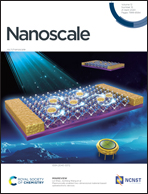Resonant scattering-enhanced photothermal microscopy†
Abstract
Photothermal (PT) microscopy is currently the most efficient approach for the detection and spectroscopy of individual non-fluorescent nano-objects based solely on their absorption. The nano-objects in current PT microscopy are usually non-resonant with the probe laser light, and the PT signal is mainly generated from the interactions of the incident probe light and the heating light-induced thermal lens around the imaged object. Inspired by the high sensitivity of the scattering field from the nano-objects near optical resonance to the variation in the local refractive index, we developed a novel strategy of resonant scattering-enhanced PT microscopy where the imaged nano-objects are near-resonant with the probe laser light. We have demonstrated this by using gold nanorods (NRs) with tunable longitudinal surface plasmon resonances. The PT signal of gold NR near-resonant with the probe light showed dramatic variation in the narrow resonance wavelength range, as small as 15 nm, and the maximal amplitude of the PT signal in this range can be enhanced up to 43 times as compared with the weak PT signal of gold NR non-resonant with the probe light. Theoretical analysis indicates that the obtained strong PT signal is mainly caused by the heat-induced variation in the polarizability of gold NR. Our novel work demonstrates the first resonant scattering-enhanced PT imaging of plasmonic nanoparticles, paving the way for the development of PT microscopy with ultra-high sensitivity toward the sensing, imaging, and spectroscopy of nanoscopic objects in complex environments.



 Please wait while we load your content...
Please wait while we load your content...